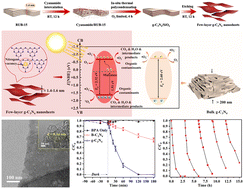Few-layer graphitic carbon nitride for enhanced visible-light photocatalytic efficiency: the role of narrow bandgap and nitrogen-vacancies†
Abstract
Graphitic carbon nitride (g-C3N4) is a famous photocatalyst with vast prospects in the field of visible-light photocatalysis, however, its actual performance has been inhibited by its feeble efficiencies in charge-carrier separation and transfer. Construction of two-dimensional g-C3N4 is one of the widely used strategies to improve its photocatalytic activity. Here, we proposed a facile spatial confinement synthesis method to synthesize a few-layer g-C3N4 nanosheet with significantly enhanced photocatalytic activity. With the aid of spatial confinement synthesis, the few-layer structure (∼1.4 nm) and introduction of nitrogen vacancies (NVs) were simultaneously achieved. The obtained few-layer g-C3N4 nanosheet showed a significantly higher (23.25-fold) BPA degradation rate of 3.162 h−1 than that of the bulk g-C3N4 (B-C3N4) under visible light irradiation. Meanwhile, the few-layer g-C3N4 nanosheet had good recyclability and excellent degradation performances toward different types of organic contaminants (phenolic compounds, antibiotics, etc.) under visible light irradiation. Many typical phenolic compounds were degraded by more than 40% in 3 h, and the antibiotic tetracycline was 100% oxidized in 60 min. Further characterization showed that the enhanced photocatalytic activity was assigned to the increased active sites, stronger photo-adsorption ability, and narrower bandgap of 2.32 eV. The density functional theory (DFT) calculations demonstrated that the introduction of NVs and the g-C3N4 structure changing from bulk to few layers were associated with the lowering of bandgap energy, increased active sites, and stronger photo-adsorption ability. It is expected that this work could provide a new perspective on the fabrication of highly efficient g-C3N4-based photocatalysts.



 Please wait while we load your content...
Please wait while we load your content...